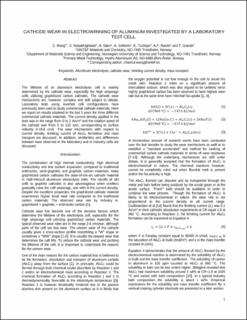| dc.contributor.author | Wang, Zhaohui | |
| dc.contributor.author | Nobakhtghalati, Saeid | |
| dc.contributor.author | Støre, Anne | |
| dc.contributor.author | Solheim, Asbjørn | |
| dc.contributor.author | Tschöpe, Kati | |
| dc.contributor.author | Ratvik, Arne Petter | |
| dc.contributor.author | Grande, Tor | |
| dc.date.accessioned | 2020-12-14T11:09:58Z | |
| dc.date.available | 2020-12-14T11:09:58Z | |
| dc.date.created | 2016-05-30T15:43:53Z | |
| dc.date.issued | 2016 | |
| dc.identifier.citation | Light Metals. 2016, 897-902. | en_US |
| dc.identifier.issn | 0147-0809 | |
| dc.identifier.uri | https://hdl.handle.net/11250/2719116 | |
| dc.description.abstract | The lifetime of an aluminum electrolysis cell is mainly determined by the cathode wear, especially for high amperage cells utilizing graphitized carbon cathodes. The cathode wear mechanisms are, however, complex and still subject to debate. Laboratory tests using inverted cell configurations have previously been used to study commercial cathode materials. Here we report on results obtained in the last 5 years for three different commercial cathode materials. The current density applied in the tests was in the range from 0 to 2 A/cm2 and the rotation speed of the cathode was from 0 to 125 rpm, corresponding to surface velocity 0-19.6 cm/s. The wear mechanisms with respect to current density, limiting current of Al4C3 formation and mass transport are discussed. In addition, similarities and differences between wear observed in the laboratory and in industry cells are discussed. | en_US |
| dc.language.iso | eng | en_US |
| dc.publisher | Springer | en_US |
| dc.relation.ispartofseries | The Minerals, Metals & Materials Series;2367-1181 | |
| dc.title | Cathode Wear in Electrowinning of Aluminum Investigated by a Laboratory Test Cell | en_US |
| dc.type | Peer reviewed | en_US |
| dc.type | Journal article | en_US |
| dc.description.version | acceptedVersion | en_US |
| dc.rights.holder | © TMS (The Minerals, Metals & Materials Society). This is the accepted and peer reviewed article. The published article is available at SpringerLink: https://link.springer.com/chapter/10.1007%2F978-3-319-48251-4_151 [DOI: 201610.1007/978-3-319-48251-4_151] | en_US |
| dc.source.pagenumber | 897-902 | en_US |
| dc.source.journal | Light Metals | en_US |
| dc.identifier.doi | 10.1007/978-3-319-48251-4_151 | |
| dc.identifier.cristin | 1358456 | |
| dc.relation.project | Norges forskningsråd: 192979 | en_US |
| cristin.unitcode | 7401,80,63,0 | |
| cristin.unitcode | 7401,80,4,4 | |
| cristin.unitcode | 7401,80,3,0 | |
| cristin.unitname | Industriell prosessteknologi | |
| cristin.unitname | Elektrolyse og høytemperaturmaterialer | |
| cristin.unitname | Bærekraftig energiteknologi | |
| cristin.ispublished | true | |
| cristin.fulltext | postprint | |
| cristin.qualitycode | 1 | |
